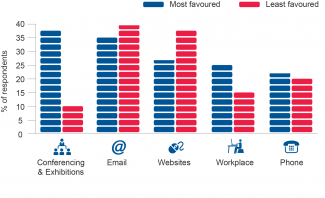
Mapping China: Fashion - Target Groups
Different people, different target groups in China. Especially nowadays, when all people turn more and more interested in fashion. Like the elder generation, curious and rich enough to afford trendy clothes. A promising but not entered market, points out Monique Maissan from Vision Textiles en waste2Wear, who also realizes that Chinais aging rapidly.
Three decades ago, only 5 percent of the population was older than 65. Nowadays, around 10 percent of the population is over this age. It is expected that China will become the world’s most aged society around the year 2030. And, twenty years later the country’s older population will increase to 330 million, which will approximately be a quarter of the total population.
Maissan: ‘Promising market for elderly fashion’
If there is one gap in the fashion market in China, it has to do with older people. That is the belief of Monique Maissan, owner of Vision Textiles and Waste2Wear, and since 1996 living in Shanghai.
Maissan may very well be called a connoisseur of the textile market. Over the years she has seen many changes, and also contributed to that with her enterprises - Vision Textiles is also based in the Netherlands, America, India, Malaysia and Singapore.
The companies of the Dutch especially make use of recycled plastic bottles - so-called PET bottles - to create fashion. It is possible, fabrics that feel like silk, but are actually made of plastic bottles which previously were filled with water or soda, and which can be very polluting for the environment.
The concept has attracted the attention of many large (fashion) brands in the world. Maissan has a diverse group of companies as her clientele: Claudia Sträter, Wehkamp, Oilily, Ducky Dons, Disney, Body Shop and Coca Cola, for example. Together with fashion designer Monique Collignon she also started the ‘Conscious Collection’ during the Amsterdam Fashion Week.
China has a bad name in sustainability, but the reality is very different, she emphasizes. "I would not say that it comes from a personal conviction of the Chinese people, but when it comes to recycling plastic bottles, this country is number one in the world. That this mainly happens because money can be earned is true, but is not the biggest problem, of course.”
The material is precious for the Rotterdam-born, who previously worked for C&A in China. In her enterprise Waste2Wear plastic is transformed into yarn, which then is woven till it becomes the finest fabrics. Besides fashion, also corporate and school uniforms are made in this way.
Top managers at large companies and multinationals invent all kinds of issues which are related to ’corporate social responsibility (CSR)’, in order to create a greener company. ,,But unfortunately, at the workplace it is difficult to convince employees about these kinds of ideas. By clothing them with uniforms made of natural materials combined with 'recycled polyester, they are themselves convinced by the fact that waste can also be a resource."
With as interesting extra, a label in it that indicates how many bottles have been used and a QR code for more information. ,,In this way you can achieve a mind shift. Often there is enormous potential in the company by people who are daily engaged in the implementation, but staff do not always realize that things can be different and better to the environment."
China, it’s an exciting market to operate in. But, says the self-employed businesswoman, it can also be a very tough one for fashion companies intending to enter the market.
"If you're talking about production, I think it is difficult to succeed here. China used to be a manufacturing country, but the production is already largely outsourced to neighboring countries because of lower costs. What the Chinese do have an interest in, is high-tech materials that can be incorporated into clothing, to name just one example. "
Looking at export, Maissan sees more options. "Not easy, but possible. Chinese people like to buy beautiful clothes from the West - though you should keep in mind is that there is about 40 per cent import duty when it comes to luxury products. Therefore, the same clothes here are also a lot more expensive than in the West. But for many wealthy clients this is not a problem. "
And then there is a market which, remarkably enough, has not yet been entered: of the elderly. Maissan:"I certainly see opportunities here. Older people have changed, they are are no longer old, slow walking women. They are vital and have become really interested in fashion clothes according to their audiences. They also have the money for it. Also sportswear, holiday clothing for Chinese seniors is not available here. Not yet, at least. "

